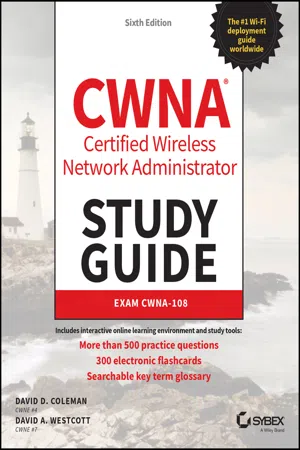
CWNA Certified Wireless Network Administrator Study Guide
Exam CWNA-108
- English
- ePUB (mobile friendly)
- Available on iOS & Android
CWNA Certified Wireless Network Administrator Study Guide
Exam CWNA-108
About this book
The #1 selling Wi-Fi networking reference guide in the world
The CWNA: Certified Wireless Network Administrator Study Guide is the ultimate preparation resource for the CWNA exam. Fully updated to align with the latest version of the exam, this book features expert coverage of all exam objectives to help youpass the exam. But passing the exam is just a first step. For over16 years, the CWNA Study Guide has helpedindividualsjump-start their wireless networking careers.Wireless networking professionals across the globe use this book as their workplace reference guide for enterprise Wi-Fi technology.
Owning this book provides you with a foundation of knowledge for important Wi-Fi networking topics, including:
- Radio frequency (RF) fundamentals
- 802.11 MAC and medium access
- Wireless LAN topologies and architecture
- WLAN design, troubleshooting and validation
- Wi-Fi networking security
The book authors have over 40 years of combined Wi-Fi networking expertise and provide real-world insights that you can leverage in your wireless networking career.Each of the book's 20 chapters breaksdown complex topics into easy to understand nuggets of useful information. Each chapter has review questionsthathelp you gauge your progress along the way. Additionally, hands-on exercises allow you to practice applying CWNA concepts to real-world scenarios. You also get a year of free access to theSybexonline interactive learning environment, which features additional resources and study aids, including bonus practice exam questions. The CWNA certification is a de facto standard for anyone working with wireless technology. It shows employers that you have demonstrated competence in critical areas, and have the knowledge and skills to perform essential duties that keep their wirelessnetworksfunctioning and safe. The CWNA: Certified Wireless Network Administrator Study Guide gives you everything you need to pass the exam with flying colors.
Frequently asked questions
- Essential is ideal for learners and professionals who enjoy exploring a wide range of subjects. Access the Essential Library with 800,000+ trusted titles and best-sellers across business, personal growth, and the humanities. Includes unlimited reading time and Standard Read Aloud voice.
- Complete: Perfect for advanced learners and researchers needing full, unrestricted access. Unlock 1.4M+ books across hundreds of subjects, including academic and specialized titles. The Complete Plan also includes advanced features like Premium Read Aloud and Research Assistant.
Please note we cannot support devices running on iOS 13 and Android 7 or earlier. Learn more about using the app.
Information
Chapter 1
Overview of Wireless Standards, Organizations, and Fundamentals
- History of wireless local area networks
- Standards organizations
- Federal Communications Commission
- International Telecommunication Union Radiocommunication Sector
- Institute of Electrical and Electronics Engineers
- Internet Engineering Task Force
- Wi-Fi Alliance
- International Organization for Standardization
- Core, distribution, and access
- Communications fundamentals
- Communication terminology
- Carrier signals
- Keying methods
How Does an Acronym Differ from an Initialism?
History of Wireless Local Area Networks
Table of contents
- Cover
- Table of Contents
- Title Page
- Copyright
- Dedication
- Acknowledgments
- About the Authors
- About the Technical Editor
- Table of Exercises
- Foreword
- Introduction
- Chapter 1: Overview of Wireless Standards, Organizations, and Fundamentals
- Chapter 2: IEEE 802.11 Standard and Amendments
- Chapter 3: Radio Frequency Fundamentals
- Chapter 4: Radio Frequency Components, Measurements, and Mathematics
- Chapter 5: Radio Frequency Signal and Antenna Concepts
- Chapter 6: Wireless Networks and Spread Spectrum Technologies
- Chapter 7: Wireless LAN Topologies
- Chapter 8: 802.11 Medium Access
- Chapter 9: 802.11 MAC
- Chapter 10: MIMO Technology: HT and VHT
- Chapter 11: WLAN Architecture
- Chapter 12: Power over Ethernet (PoE)
- Chapter 13: WLAN Design Concepts
- Chapter 14: Site Survey and Validation
- Chapter 15: WLAN Troubleshooting
- Chapter 16: Wireless Attacks, Intrusion Monitoring, and Policy
- Chapter 17: 802.11 Network Security Architecture
- Chapter 18: Bring Your Own Device (BYOD) and Guest Access
- Chapter 19: 802.11ax: High Efficiency (HE)
- Chapter 20: WLAN Deployment and Vertical Markets
- Appendix A: Answers to Review Questions
- Appendix B: Abbreviations and Acronyms
- Index
- Comprehensive Online Learning Environment
- End User License Agreement